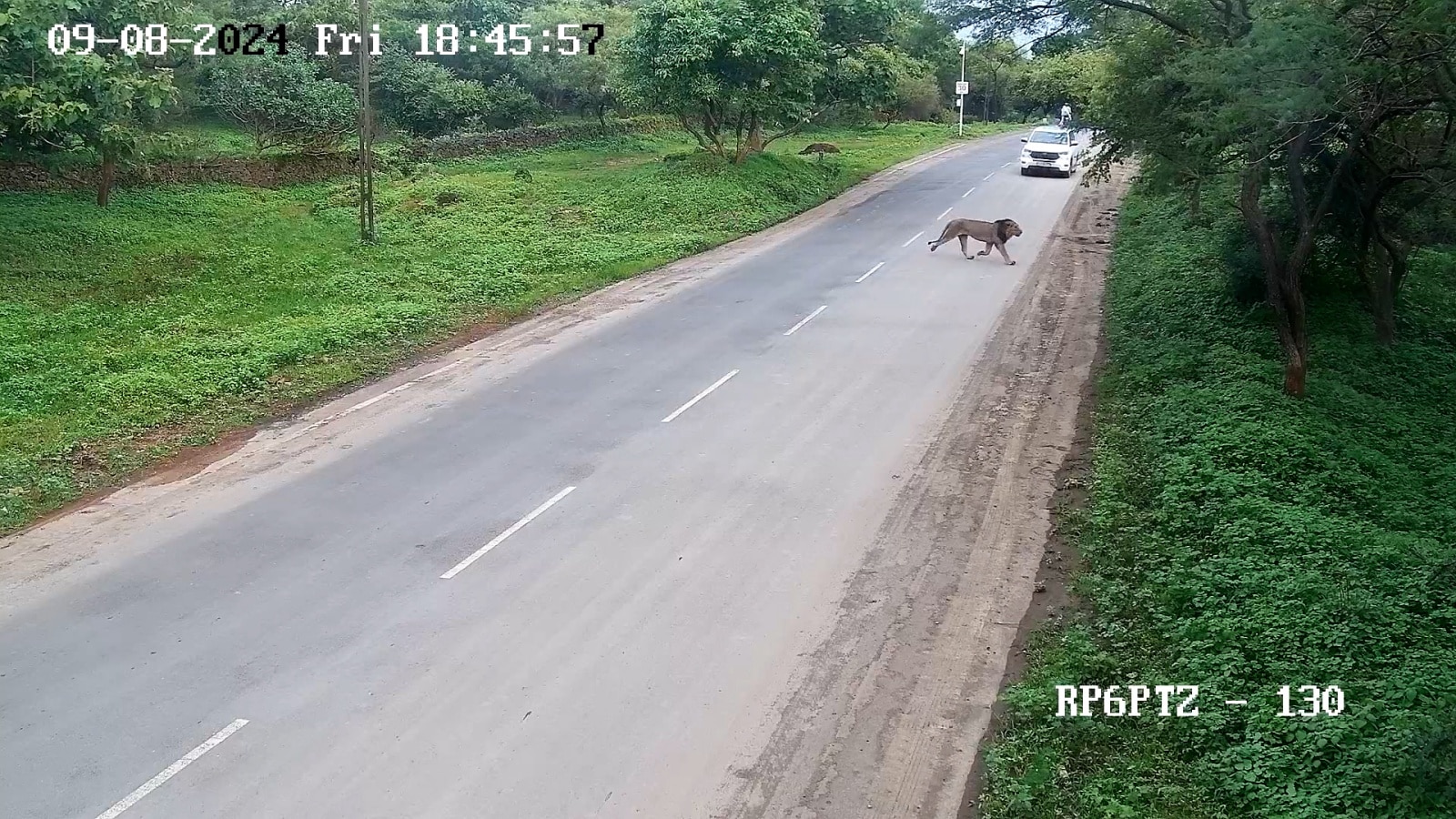Highway passing via Gir gets speed monitoring system to save lions
Forest officers said that the objective is to address the menace speeding vehicles pose to the safety of wildlife and humans.
 The Gujarat forest department has installed high-tech speed monitoring system as well as thermal and optical cameras along a 1-km stretch of state highway 26. (Express Photo)
The Gujarat forest department has installed high-tech speed monitoring system as well as thermal and optical cameras along a 1-km stretch of state highway 26. (Express Photo)To prevent death of wild animals and ensure safety of humans taking the roads criss-crossing Gir National Park and Wildlife Sanctuary (GNPWLS), the habitat of Asiatic lions, the Gujarat forest department has installed high-tech speed monitoring system as well as thermal and optical cameras along a 1-km stretch of state highway 26.
As part of a pilot project, the department has installed 54 cameras and 20 LED display units along the 1-km stretch, extending towards the forest from Vavaniya Ness forest check-post on the western periphery of GNPWLS.
The cameras include 16 thermal and optical cameras, eight pan-tilt-zoom (PTZ) cameras and four automatic-number-plate-recognition (ANPR) cameras. Called Gir Speed Monitoring System (GSMS), the system also includes four speed guns, four strobe lights.
 As part of a pilot project, the department has installed 54 cameras and 20 LED display units along the 1-km stretch, extending towards the forest from Vavaniya Ness forest check-post on the western periphery of GNPWLS. (Express Photo)
As part of a pilot project, the department has installed 54 cameras and 20 LED display units along the 1-km stretch, extending towards the forest from Vavaniya Ness forest check-post on the western periphery of GNPWLS. (Express Photo)
The system is controlled by a control unit integrated with the Gir Hi-Tech Monitoring Unit at Sasan – the headquarters of GNPWLS around 10 km away – through a dedicated network of cables, the forest department said in a statement on Saturday.
A sub-adult lion was run over by a truck near Goradka village in Amreli district’s Savarkundla on Savarkundla-Mahuva highway in Gir (East) Wildlife Division in November 2021. In March 2021, a lioness was run over by a truck in the parking bay of Pipavav port near Rajula in Amreli when the port fell in the jurisdiction of Amreli Social Forestry Division. In January this year, a lioness had died after being hit by a car near Amreli’s Bagasara town in Amreli Social Forestry Division.
Forest officers said that thermal and optical cameras are capable of detecting thermal signatures of any animal, bird or vehicle. If the cameras detect presence of any wild animals or birds on or along the highway, with the help of the system, the department will be able to alert vehicle drivers about the same and instruct them to slow down. The speed guns will display on LED units the speed of moving vehicles passing on the stretch while ANPR cameras will be able to capture details of vehicle registration plates.
 The cameras include 16 thermal and optical cameras, eight pan-tilt-zoom (PTZ) cameras and four automatic-number-plate-recognition (ANPR) cameras. (Express Photo)
The cameras include 16 thermal and optical cameras, eight pan-tilt-zoom (PTZ) cameras and four automatic-number-plate-recognition (ANPR) cameras. (Express Photo)
Forest officers said that the objective is to address the menace speeding vehicles pose to the safety of wildlife and humans. The department has been testing the pilot project, which has cost around Rs 1 crore, for the last two months.
GNPWLS, which falls in the Junagadh Wildlife Circle, as well as other protected areas spread across Junagadh, Gir Somnath, Amreli and Bhavnagar districts are the world’s only natural habitat of Asiatic lions.
However, GNPWLS – spread over 1,153 sq km — is criss-crossed by state highways 26, 33, 98 and 104. The total length of highways inside the Gir is around 100 km and everyday, hundreds of vehicles traverse them, said Aradhana Sahu, Chief Conservator of Forests of Junagadh Wildlife Circle.
While no major accidents involving wild animals have been reported on state highway 26 in recent years, more lions are dying on Pipavav-Surendranagar railway line in Amreli district in the jurisdiction of Gir (East) and Shetrunji Wildlife Division. Eight lions have been run over by trains on this track in around 13 months and the forest department and the Railways are struggling to prevent casualties of lions. The latest lion-train fatal collision was reported from Amreli’s Lilia on July 24 this year.
Sahu said, “Though incidents of roadkills are not as high in Gir as in other protected areas elsewhere in India, the vehicular traffic on these highways remains high during festivals and tourism season and therefore, the threat of roadkills remains a concern. While there have not been many lion casualties in road accidents, we should try to prevent any casualty which is preventable.”
“Additionally, Gir is not only about lions. There are a number of other mammals that cross the highways often, especially at night and remain vulnerable to road accidents,” she added.
State highway 26 is the arterial road providing access to Sasna, the major eco-tourism hub. Tourists going towards destinations like Somnath and Union Territory of Diu also use this highway.
“Such a system has been installed in Kaziranga National Park and has been very successful… The pilot project for Gir was approved last year. We are testing the system and the results have been encouraging. Just the previous night, the system detected two lions on the road,” Sahu said.
“In future, other stretches of the highways in Gir can be brought under such monitoring systems if needed,” she added.
Mohan Ram, Deputy Conservator of Forests of Sasan Wildlife Division and superintendent of GNPWLS, said the GSMS would also help in tackling wildlife crime. “The system will alert vehicle drivers in advance about movement of wildlife on the road ahead. But if accidents do take place, thanks to the ANPR cameras, the forest department will be able to identify vehicles immediately and take action,” he added.







